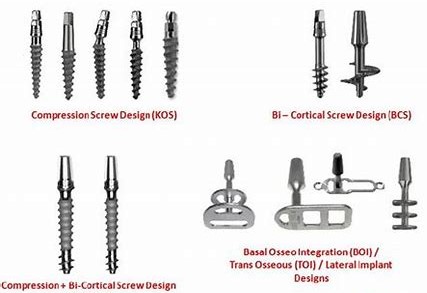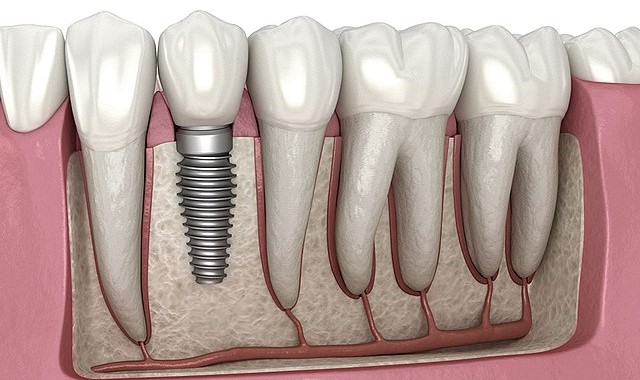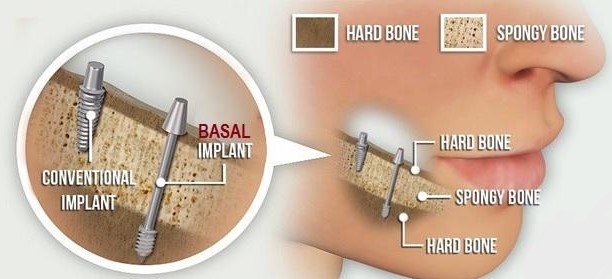Pterygoid implants are a type of dental implant that differ from traditional implants in their method of placement and design. Where traditional implants rely on a strong bone structure for support, pterygoid implants are anchored into the pterygoid process of sphenoid bone, a bone that forms the base of the skull.
The Zygomatic implants are fixed in the zygomatic process of the malar bone, a rhomboidal bone that forms the prominent portion of the face, also known as cheekbone.
Both the bones have hardness and density to provide exceptional anchorage and so this makes them a suitable option for patients with insufficient bone or other structural issues.

Indications for Pterygoid and zygomatic Implants
These implants are typically recommended for patients with the following conditions:
– Severe bone loss due to tooth loss, gum disease, or injury
– Absent or inadequate upper jawbone structure
– Large maxillary sinuses or nasal cavities
– Patients who have undergone radiation therapy in the head and neck region
Contraindications
Certain conditions may preclude a patient from receiving pterygoid implants, including:
– Active periodontal disease
– Active cancer or chemotherapy treatment
– Blood clotting or bleeding disorders
– Uncontrolled diabetes
– Immunosuppression or autoimmune diseases
COST
The cost of pterygoid and zygomatic implants can vary widely depending on various factors, such as the location, the complexity of the surgery, and the experience of the dental professional performing the procedure. Additionally, the cost of these implants may be higher than traditional dental implants.
On average, pterygoid and zygomatic implant surgeries can cost anywhere from $20,000 to $40,000 per arch in the United States. However, this cost may not include costs such as pre-operative tests, sedation, and the prosthesis (teeth replacement).
It is best to consult with a dental professional specializing in these procedures to get a precise estimate of the cost of pterygoid and zygomatic implants, and to understand the payment options available, which may include financing, insurance coverage, or payment plans.
Advantages
Pterygoid and zygomatic implants offer several advantages over traditional implants, including:
– Long-lasting: Pterygoid implants have been shown to have a high survival rate, with some studies showing success rates of up to 97%.
– Improved stability: Due to their anchorage in the cheekbone, pterygoid implants offer improved stability and reduced chances of implant failure.
– Reduced need for bone grafting: In cases of severe bone loss, pterygoid implants can often be used instead of bone grafting procedures, which may have associated risks and complications.
– Immediate loading: Pterygoid implants can often be loaded with dental restorations immediately after placement, saving time and reducing treatment duration.
Disadvantages
While pterygoid implants have many advantages, they also have a few potential disadvantages, including:
– Higher cost: Pterygoid implants may be more expensive than traditional implants due to the specialized materials and techniques used.
– More complex procedure: The placement of pterygoid implants requires specialized training and skill, and may be more invasive than traditional implant procedures.
– Reduced sensation: Due to the close proximity to nerves in the cheekbone, pterygoid implants may cause a loss of sensation in some patients.
Conclusion
Pterygoid and zygomatic implants provide a valuable option for patients with insufficient bone or other structural issues who are seeking dental restoration. While the procedure may be more complex and expensive than traditional implants, the benefits of pterygoid implants can help patients regain their confidence and quality of life. As with any dental procedure, it is important to consult with a qualified dentist who can evaluate the patient’s individual situation and recommend the best course of treatment.
Also Read About Dental Implants
Also Read About FAQs For Dental Implants
FAQs
Here are some frequently asked questions (FAQs) about pterygoid and zygomatic implants:
1. What are pterygoid and zygomatic implants?
Pterygoid and zygomatic implants are types of dental implants that are used in cases where traditional implants cannot be placed due to insufficient bone density or volume. These implants are anchored into the upper jawbone, either on the zygomatic bone (cheekbone) or the pterygoid process (near the back of the cheekbone).
2. Who can benefit from pterygoid and zygomatic implants?
Pterygoid and zygomatic implants are typically recommended for patients with severe bone loss in the upper jaw, particularly in the posterior region. Candidates for these types of implants must have enough healthy, dense bone in the zygomatic or pterygoid region to support the implants.
3. How are pterygoid and zygomatic implants placed?
The placement of pterygoid and zygomatic implants is a complex surgical procedure that typically requires general anesthesia. The implants are inserted through incisions in the gum tissue and anchored into the zygomatic or pterygoid bone, providing a stable base for the prosthetic teeth.
4. What is the success rate of pterygoid and zygomatic implants?
Pterygoid and zygomatic implants have a high success rate, ranging from 80% to 95%. Success depends on various factors, including the patient’s oral health status, the amount of bone available for the implants, and the experience and skill level of the surgeon.
5. Is the recovery period after pterygoid and zygomatic implant surgery long?
The recovery period after pterygoid and zygomatic implant surgery can be longer than traditional implant surgery due to the complex nature of the procedure. Patients may experience some discomfort and swelling for several days, and a soft-food diet is recommended for the first few weeks following surgery.
6. Is special care required after pterygoid and zygomatic implant surgery?
Patients will need to follow specific post-operative care instructions provided by their surgeon. This includes good oral hygiene practices and regular follow-up visits with the dentist.



